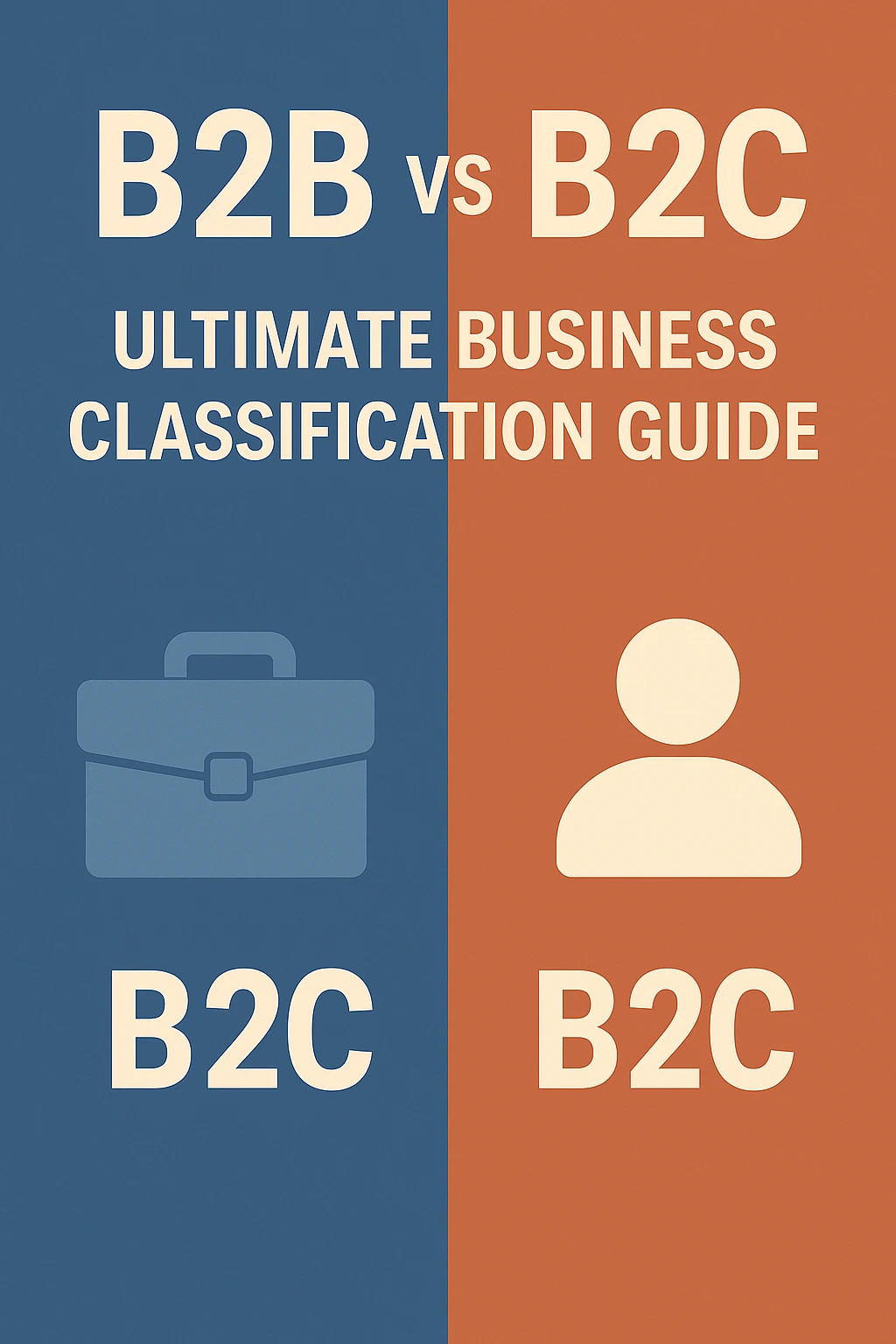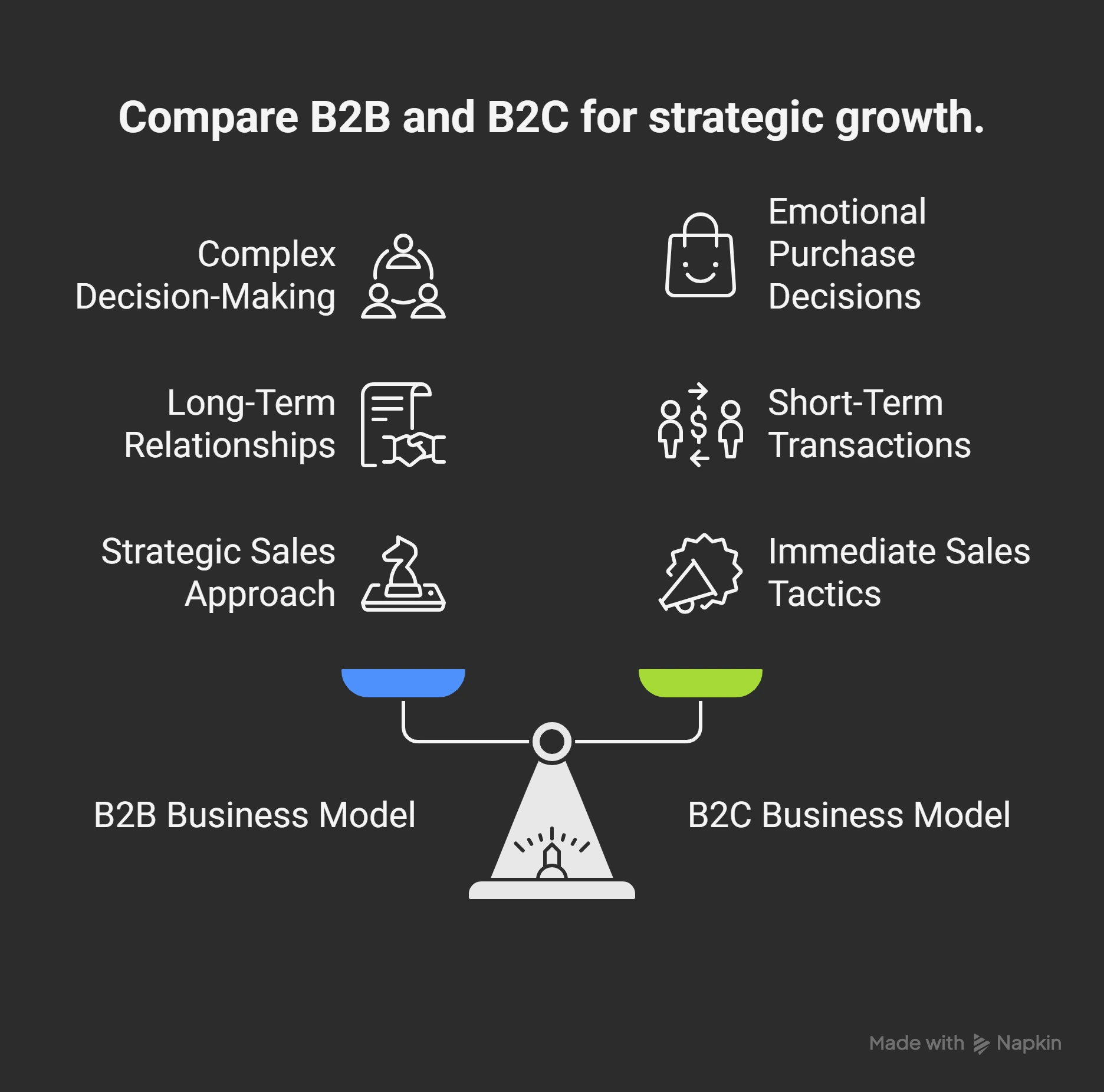
B2B vs B2C: Ultimate Business Classification Guide
Summary:
In 2025, understanding B2B vs B2C is essential for businesses aiming to grow and stay competitive. Proper business classification methods help companies identify their target audience, design effective marketing strategies, and streamline sales processes. The distinction between B2B and B2C affects every aspect of operations, from pricing and product development to customer engagement and decision-making. With the rise of hybrid models like B2B2C and D2C, businesses must also consider mixed approaches to reach multiple audiences efficiently.
This guide explores the B2B business model and B2C business model, explains their key differences, and highlights emerging trends in 2025. By understanding these models and implementing accurate classification, companies can improve resource allocation, optimize marketing campaigns, and enhance customer satisfaction. Tools like PowerDialer.ai can further support sales and outreach, ensuring that your business strategy aligns with your audience and drives measurable growth.

B2B versus B2C knowledge is more essential than ever before for companies these days in 2025. Accurate business classification method ensures your product, sales, and marketing strategy reaches the perfect customers. Classification not just impacts conversion prices but also ensures long-term success in business.
The below is an outline of B2B model vs B2C model, discusses new 2025 business models, and illustrates how companies can properly place themselves so that they are as efficient as they possibly can be. Technology like PowerDialer.ai can even make follow-ups more efficient and automate them.
Learn B2B vs B2C in 2025

With the world as busy as it is today, knowing B2B vs B2C has never been more crucial prior to now. Effective classification of your business allows you to tailor marketing strategies, optimize sales processes, and target product development around customer demand. With hybrid models, subscription services, and AI tools like PowerDialer.ai growing more mainstream, effective classification is the key to driving most growth. Misclassification can be the price of wasted resources, ineffective conversion rates, and lost opportunity. By 2025, businesses must not only segment B2B from B2C but also discern differences between the two types if they are to succeed. Effective classification increases efficiency, maximizes customer targeting, and ensures sales and marketing activities achieve returns measurable in material terms. This book will present a comprehensive outline of business classification methods and instructions step by step to help businesses succeed.
What is Business Classification?
Business classification is the process of putting firms into categories based on to whom they are marketing, what they make, and where they market. In 2025, successful classification enables firms to implement measures that are appropriate for customer requirements. Modern-day firms have to put hybrid models, AI-based marketing, and consumer actions into consideration when classifying.
Why B2B vs B2C Matters in 2025
B2B and B2C segmentation is more crucial than ever before. Its disposal of the wrong customer has budget wastage risks and lowering sales efficiency. Segmentation informs marketing communications, selling effort, and product development and hence focus is put on businesses or solo-off consumers.
How Classification Affects Growth
Accurate classification affects every area of a business. From design to products, through advertising campaigns and pricing policy, recognizing whether you are B2B, B2C, or hybrid enables you to budget properly, not waste effort, and enhance overall market performance.
What is B2B and B2C?
B2B (Business-to-Business)
B2B are companies selling products or services to businesses rather than end-consumers. Such transactions include higher value, higher volume transactions and longer buying cycles. Professional services, manufacturing, wholesale, and SaaS are common industries that operate in this paradigm. B2B operations are centered on relationship-building, demonstrating return on investment (ROI), and providing tailored service. The marketing activity is consultative and educational in orientation, e.g., webinars, whitepapers, and account-based marketing efforts. Unlike B2C, the purchasing process in B2B is structured with multiple decision-makers and extensive analysis before buying.
Examples of B2B Companies
- Salesforce (business software)
- Intel (factory components)
- HubSpot (marketing software for businesses)
- How B2B Firms Differ
How B2B Operations Differ
B2B firms differ from B2C due to the kind of customers and transactions they have. B2B businesses are long-term alliances, with historically addressing months- or year-long accounts, in contrast to one-time buy transactions. Sales are incremental, with various decision-makers and careful consideration of ROI. Marketing is consultative and informative, with long product demonstrations, whitepapers, and webinars. Unlike B2C, B2B appreciates personalized service, negotiation, and contract negotiation. Automation software and technology such as PowerDialer.ai are usually installed to automate touch, track interactions, and effectively build leads. B2B operations are strategy- and relationship-driven compared to consumer-driven B2C operations.
How Understanding B2B Operations Drives Maximum Gains
- Relationship-Driven: Client relationships are more solidified, and retention and long-term revenue are assured.
- More Value Transactions: Transactions of higher value, maximizing overall profitability.
- Strategic Sales Process: Long sales cycles allow opportunity for consultative selling and higher ROI.
- Personalized Service: Personalized solutions meet one-to-one business client requirements.
- Effective Lead Management: Solutions such as PowerDialer.ai enable interaction tracking and effective lead management.
- Optimal Utilization of Resources: Real-time insights into B2B operations help teams identify high-value accounts.
B2C (Business-to-Consumer)
B2C firms sell products or services directly to single end-consumers for private consumption. The nature is convenience, price, and emotion-driven with generally faster purchasing decisions. Consumer apparel and footwear, e-tailing, subscription boxes, and consumer mobile apps are some examples. B2C marketing relies upon promotion, brand, and targeted efforts to influence buying behavior. Convenience, brand name, and social proof compel clients and not long-term return on investment. Selling in B2C is quick and impulse-driven versus B2B with high-volume transactions and customer satisfaction being in the spotlight.
Examples of B2C Companies
- Amazon (online shopping)
- Netflix (streaming media)
- Nike (consumer footwear and apparel)
Learning B2C Consumer Behavior
B2C consumer behavior is the process of how consumers shop for personal use.
As opposed to B2B, these will be brief, emotive, and open to convenience, value for money, brand reputation, and social acceptability considerations. Consumers are welcoming of stimulating, engaging content and offers that facilitate or enhance the shopping experience. Incentives, offers, reward programs, and segmented marketing are utilized by marketing approaches to stimulate conversion. Knowing B2C behavior allows companies to create campaigns that attract the target market, drive customer satisfaction, and cause repeat buying. Companies that know buying behaviors can integrate product offerings, reduce use complexity, and maximize overall sales performance.
Differences Between B2B and B2C
Target Audience
B2B companies address organizations, whereas B2C addresses individual customers. Understanding the audience ensures communication and campaigns are crafted to make a difference. Target audience strategies are required in order to target the right decision-maker or purchaser.
Sales Cycle and Decision-Making
B2B sales cycles take longer and involve more stakeholders. B2C buying is faster with the client making purchases on mood swings or impulse. Companies keep all this in mind while distributing marketing and selling approaches in ratio.
Marketing and Sales Strategies
- B2B: Relationship marketing, account strategy, content education, and lead nurturing.
- B2C: Emotion marketing, promotions, discount schemes, and convenience campaigns.
With AI technology such as PowerDialer.ai can maximise reach for each model through the leverage of follow-ups and enhanced conversion, automated.
Pricing and Transaction Volume
B2B pricing is transacted in bulk orders or repeat business as standards. B2C pricing is standardized, with high volume but low-value transactions. Classification correctly ensures alignment of price by customer expectations and business objectives.
Real-Life Company Examples
- B2B: Slack, HubSpot, Intel
- B2C: Netflix, Nike, Amazon
Analysis of the examples provided above can establish how business models define marketing, sales, and operations. Hybrid models like B2B2C, where the two models are applied, also exist.
Modes of Business Categorization in 2025
Revenue-Based Categorization
Revenue defines business with B2B businesses providing higher revenue per sale and B2C businesses believing in numbers. Landmarks for revenue give companies data regarding position in the market and strategy formulation for growth.
Segmentation of Customer Base
Segmentation based on whether customers are businesses or individuals allows for targeted targeting and customized campaigns. Segmentation appropriately leads to greater engagement, conversion, and long-term retention.
Product or Service Type
Industrial goods, professional services, and software are B2B products. Products that are sold to consumers are B2C products such as clothes, gadgets, or subscription services. Product type is used in aligning marketing and sales plans.
Sales Channels and Distribution
- B2B: Direct selling, wholesaling, account managers, or specialist websites.
- B2C: Bricks-and-mortar, e-commerce, mobile commerce, and social commerce.
With the appropriate channels, product delivery and customer satisfaction can be simplified.
New Hybrid Models
Hybrid models like B2B2C, D2C, and subscription services are models that combine the best of B2B and B2C and allow business firms to serve distinct audiences and diversify revenue streams.
Why Proper Classification is Important
Accurate classification makes marketing more productive, puts pricing in customer value, targets product development, and increases competitiveness. Misclassification leads to investing in vain and lost growth potential, while accurate classification brings your business strategy to data-based and targeted levels.
How to Know If Your Business is B2B or B2C
Step 1: Identify Your Primary Buyer
Make a decision whether your key buyer is consumer or business. This drives sales strategy, marketing channels, and messaging.
Step 2: Study Purchase Behavior
Study purchase frequency, decisioning, and buying quantity. B2B is formal and long; B2C is emotional and fast.
Step 3: Watch Sales and Marketing Processes
Watch the way leads are qualified, sales are completed, and campaigns are conducted. Are the processes convenience-based or relationship-based?
Step 4: Hybrid or Mixed Models
Most modern-day businesses are B2B2C or D2C. Hybrid models require correct segmentation and marketing alignment. PowerDialer.ai can manage such a complex sales process effortlessly.
Conclusion
B2B vs. B2C segmentation is the key to success in 2025. Correct segmentation guarantees that marketing, sales, and product planning is in alignment with the needs of the customer. Businesses correctly specifying themselves as B2B, B2C, or hybrid have competitive edge, maximize utilization, and maximize growth possibilities.
Ready to fine-tune your 2025 plan?
Accurately classify your business and contact us to schedule a demo of PowerDialer.ai to automate sales outreach and maximize outcomes.
FAQs
1. What is the primary difference between B2B and B2C?
B2B refers to business organizations with relationship-driven sales; B2C refers to individual customers with emotionally driven buys.
2. Can an enterprise be both B2B and B2C?
Yes. Hybrid formats like B2B2C allow companies to sell to businesses and customers at low costs.
3. Which will be more appropriate for startups in 2025?
That depends on your customer base. B2B has larger deals, B2C has quicker revenue, and hybrid models have agility.
4. How are B2B and B2C marketing approaches different?
B2B is education, trust, and relationships; B2C is emotion, convenience, and brand interaction.
5. What are hybrid business models such as B2B2C?
Hybrid models mesh the B2C and the B2B, both selling to companies but also directly to consumers.
